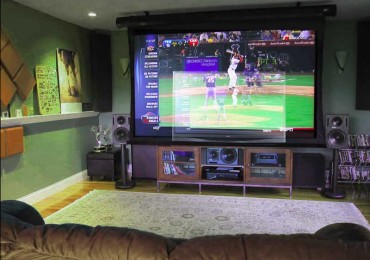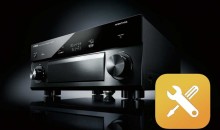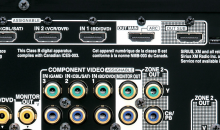Using Dual HDMI Outputs
Using dual HDMI outputs is now possible on more and more AV receivers. Some products are simply doubling the HDMI output and allowing you to run another parallel output to a different room. These systems don’t allow you to select a discrete input or source and send it to a different room. Rather, they let you experience the same singe-source entertainment in a different room—nice if you happen to want to send some of your HD sources around the home. This type of system is even better if you have a whole-home control system.
With a system like this you could run an LCD television for daytime viewing, and then drop down a screen overtop for nighttime projector presentations. Both screens get the same feed, but you now don’t have to bother with an external HDMI splitter. You also don’t have to swap out cables, which is not only a hassle, it is guaranteed to break those delicate HDMI connections on the back of your receiver.
But What About a Second, Assignable HDMI Output?
Some advanced AV receivers from Denon, Yamaha and others have a second HDMI output that is discrete. It can truly get an independent signal and route it to a second zone in the home. This is significant, because it means that, with the right remote, you can operate a second stereo or even home theater in another room in your house without having to repurchase your DVR or another Blu-ray Disc player.
And really, this is a long time coming. Analogue Zone 2 outputs have been around for a long long time, but the dawn of HDMI and the age of digital video and audio has retarded the industry and made these advances only for the “elite” products. As technology gets more and more advanced, these technologies are starting to become more commonplace and I believe we’ll see dual discrete HDMI outputs on players costing less than $1000. As that happens, look for third zone systems start to come to market, whereby you can truly have a product that is the digital hub of your entire system.
The Pros and Cons
There are arguments for more local control, of course. For one, you don’t take down the entire home when your receiver needs to be repaired. With a two zone system, you lose two rooms in one when something breaks. Also, local control means you have much simpler options for remote control over the components. Finally, when you aren’t running a second zone, you don’t have to run the necessary wiring to make the features of that second zone a reality (an IR remote line, speaker cable or even the extended-run HDMI cable itself—just to name a few).
[top-seller category_id=’21’ product_count=’4′ title=’Top Selling AV Receivers’]
Using Dual HDMI Outputs with Longer-run HDMI Cables
One major consideration when using dual HDMI outputs and running long HDMI cables is that they require active EQ technology. HDMI cables less than 6 feet will work under almost any circumstances, but when you get upwards of 2-3 meters, and even all the way to 5 meters or more, you have to have an active cabling solution to get the signal to work properly. This will be even more significant with HDMI 2.0 and 4K signal transmission. HDMI cables can simply no longer work as analogue copper cabling solutions. The requirements are too stringent and the signal degrades too much over the cable. We’re seeing this active cabling technology drop in price dramatically, however it will mean that when you run a longer cable, you want to make sure you take any extra costs into account. It’s the only hope you have of that cable not going obsolete the next time you update your AV receiver or sources. Other advances, like HDBaseT (HDBT) are also promising and offer advances like sending digital video and audio over 100 meters on a single shielded CAT6 cable. Look for these in upcoming AV flagship receiver models.
Using dual HDMI outputs on a receiver can be very cool. With larger installs, it’s often good to be minimal in your use of that second zone. There are far more potential pitfalls than advantages in my opinion. But for smaller installations, having that second HDMI can be a really neat way to get new and better life out of your home theater. Plus, you can consider running that dual LCD/projector system you’ve always dreamed about!







how do i hook up my cable box, so that the signal goes to my 4k tv and to the stereo at the same time. i want to be able to watch cable without turning on my stereo on and i want to watch cable through my stereo for picture and better sound.